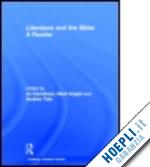Part 1: The Relationship Between Literature and the Bible Chapter 1. Introducing the Study of Literature and the Bible Introduction and Further Reading (a) Erich Auerbach, ‘The Scar of Odysseus’ from Mimesis: The Representation of Reality in Western Literature (b) Hans Frei, The Eclipse of Biblical Narrative (c) Meir Sternberg, The Poetics of Biblical Narrative: Ideological Literature and the Drama of Reading (d) Susan A. Handelman, The Slayers of Moses: The Emergence of Rabbinic Interpretation in Modern Literary Theory Chapter 2. Ways of Reading Introduction and Further Reading (a) Stephen Prickett, Words and The Word: Language, Poetics and Biblical Interpretation (b) David Lyle Jeffrey, People of the Book: Christian Identity and Literary Culture (c) Emmanuel Levinas, Beyond the Verse (d) Geoffrey Hartman, ‘The Struggle for the Text’ in Geoffrey Hartman and Sanford Budick, eds., Midrash and Literature Chapter 3. Reception History Introduction and Further Reading (a) Wolfgang Iser, ‘Conditions of Interaction’, from The Act of Reading: A Theory of Aesthetic Response (b) Hans-Georg Gadamer, Truth and Method, 2nd rev ed., Trans. Joel Weinsheimer and Donald G. Marshall (c) Yvonne Sherwood, A Biblical Text and its Afterlives: The Survival of Jonah in Western Culture Part 2: Literary Reading Chapter 4. Translation Introduction and Further Reading (a) Walter Benjamin, ‘The Task of the Translator’, in Illuminations. Ed Hannah Arendt (b) Gerald Hammond, The Making of the English Bible (c) Robert Alter, ‘To The Reader’, in Genesis (d) Jacques Derrida, ‘Des Tours de Babel’ in Jacques Derrida, Acts of Religion, ed. Gil Anidjar (e) Valentine Cunningham, ‘Thou Art Translated: Bible Translating, Heretic Reading and Cultural Transformation’ Chapter 5. Multivocality Introduction and Further Reading (a) Mikhail Bakhtin, ‘Discourse and the Novel’ in Dialogic Imagination: Four Essays, trans., Caryl Emerson and Michael Holquist (b) Daniel Boyarin, ‘Towards a New Theory of Midrash’, from Intertextuality and the Reading of Midrash (c) Alicia Ostriker, ‘Psalm and Anti-Psalm: A Personal Interlude’ (d) David Tollerton, ‘Reading Job as Theological Disruption for a Post-Holocaust World’ Chapter 6. Metaphor & Allegory Introduction and Further Reading (a) Northrop Frye, ‘The Double Vision of Language’ (b) Paul Ricouer, ‘The Nuptial Metaphor’ (c) Harold Fisch, Poetry with a Purpose: Biblical Poetics and Interpretation Part 3: Theological Interpretation Chapter 7. Parables Introduction and Further Reading (a) Frank Kermode, The Genesis of Secrecy (b) J. Hillis Miller, Tropes, Parables and Performatives (c) Sally McFague Teselle, Speaking in Parables: A Study in Metaphor and Theology (d) Susan Colon, Victorian Parables Chapter 8. Genesis Introduction and Further Reading (a) Stanley Fish, Surprised by Sin: The Reader in Paradise Lost, 2nd ed (b) Regina Schwartz, Remembering and Repeating: Biblical Creation in Paradise Lost (c) Terry Wright, The Genesis of Fiction: Modern Novelists as Biblical Interpreters (d) Mieke Bal, ‘First Memories and Second Thoughts’ in Loving Yusuf: Conceptual Travels from Present to Past Chapter 9. Salvation, Transformation and Apocalypse Introduction and Further Reading (a) Graham Ward, ‘Suffering and Incarnation’, in Ward, ed., The Blackwell Companion to Postmodern Theology (b) Eve Kosofsky Sedgwick, Epistemology of the Closet (c) Paul Fiddes, The Promised End: Eschatology in Theology and Literature (d) Jon Roberts, ‘Wordsworth’s Apocalypse’











